By Thomas Hoel
The ubiquitous M1 carbine, the most produced U.S. standard military weapon of all time, has endeared itself to generations of Soldiers and Civilians alike, and with each new generation of firearms aficionados, collectors, and shooters the little wartime wonder attracts legions of new and dedicated fanciers and followers. To the collector, and shooter, of Title II NFA weapons the M1’s progeny, the M2 carbine, has a special place: it is one of the best guns to start a collection with and enter the world of NFA weapons. It is a fine and very fun shooter, as acquisition and maintenance costs are low, and it is a gun with significant historical import. The M2 carbine has endured throughout the decades to grow into one of the most desirable Civilian NFA pieces for exactly the same reasons it won over thousands of GI s during its military service: it is a light, handy, well engineered weapon with a natural feel to it that is easy to master and enjoy the sport of Full?automatic shooting.
The M1 begets the T4; Origins of the familiar M2
When the Light Rifle Program was introduced, one of the initial specifications was for the selected design to have an automatic fire capability. This specification was quickly dropped in the haste to get the selection process underway. It was initially found that among the entries in the Light Rifle Trials difficulties were encountered in handling many of the guns in full?automatic fire using the new cartridge that had been selected. By the time the successful entrant, submitted nearly too late for consideration, from the Winchester Repeating Arms Company, had passed the Trials and been selected and placed into the hands of the Ordnance Board for standardization and conversion to series production, many were still pushing for the full automatic feature to be included. With the winds of War blowing ever stronger in the Fall of 1941 the Military Liason Commander to the program, Colonel Rene Studler of the Ordnance Board, vetoed this feature as being a hold up to starting immediate production as it would have necessitated a period of engineering study and redesign he deemed to be too long to manage, so it was to be standardized as only a semi?automatic design. As it turns out in the end, the final configuration of the full automatic conversion was so quickly developed that it would have necessitated almost no slow down to the initial manufacturing set up program!
Among its other unique qualities the M1/M2(M3) carbine is the only US standard weapon in which the designs for the receiver between the semi?automatic and the full?automatic versions (where there exists such a distinction) are identical, an all important fact which allowed the design to be easily and readily altered to offer a selective fire capability from its original semi?auto only issuance (and a fact that causes ATF, in modern times, to absolutely HATE this gun!). The first Wartime call for an addition of the full automatic feature to be redesigned into the M1 carbine came from the Pacific Theater of Operations (PTO) following horrific encounters with the Japanese Army in close range jungle combat in which US soldiers had fared badly. The resultant analysis of these encounters convinced many that the OPTION of selective full?automatic fire would enhance the Carbines’ battle effectiveness in close range or confined scenarios. (This was to be the continuing theme song of the Carbines’ converted status: that the selective fire option was indeed an OPTION and NOT to be thought of as the sole means of usage and fire discipline.) In early 1944 then, the Ordnance Department set forth a requirement for the development of a suitably engineered redesign of the standard semi?automatic components to allow a conversion to selective fire that was able to be implemented into the normal production lines of the already being produced M1 variant. The most desirable aspect of any conversion, from the Ordnance Boards’ point of view, would be to allow uninterrupted production while incorporating the new components in the production process. Along with the Army’s Springfield Armory the two original prime contractors to the Carbine Program, Winchester Repeating Arms and General Motors Corp.? Inland Division, were the only developers of practical conversion methods that did not adversely hamper the production programs then underway, as such only their proprietary methods were ever seriously considered.
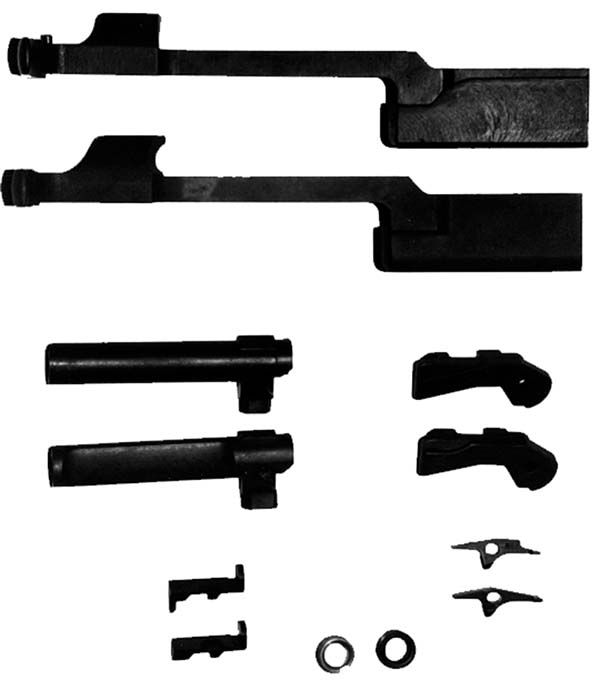
During the spring of 1944 Inland had been developing a conversion in?house under the authority of two Inland Engineers, Paul H. Hamisch and Frederick W. Sampson, that was essentially a redesign of the existing M1 Carbine fire control system with the addition of the necessary components to allow a selection of fire control modes. They managed to achieve a satisfactory conversion, while only minimally altering the standardized production design, with the addition of few new parts and some simple modifications to existing ones. This was their submission that was designated, when assembled onto a normal M1 Carbine, the T4 and that met the approval of the Board for all aspects of design requirements and production processes. For firing trials as a Service Test Type at Aberdeen Proving Grounds in July, 1944, Inland supplied 4 T4 carbines built from production M1s to the Army. Following these trials, in early September, Col. Studler recommended that the T4 design be tested for standardization, and to facilitate this a contract was let to Inland for the production of approximately 500 T4 carbines. On September 14, 1944, at the conclusion of extensive Service Test Trials by various units of the Army, the Inland T4 was recommended “..without reservation” for standardization as the “U.S. Carbine, Caliber .30, M2”
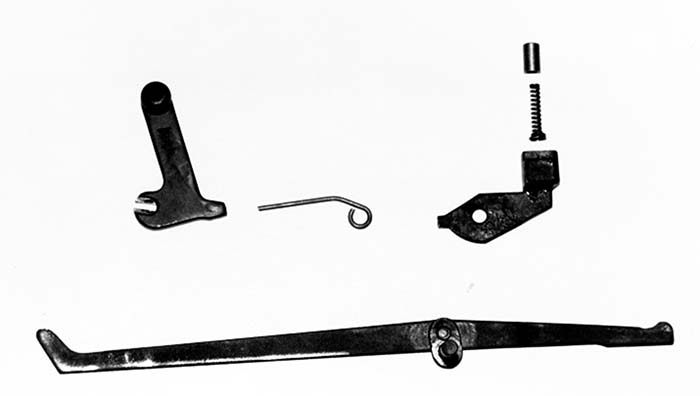
Winchester had not been so quick to jump on the bandwagon when the Board called for a conversion. They had already demonstrated at Aberdeen Proving ground in March of 1944 a proprietary design, called the Winchester “Number 3 Mechanism”, which they felt would show its superiority over any others. It has been suggested that Winchester had been expecting, unofficially, an approval of their design for the conversion request, and so had not exerted themselves to the Board.
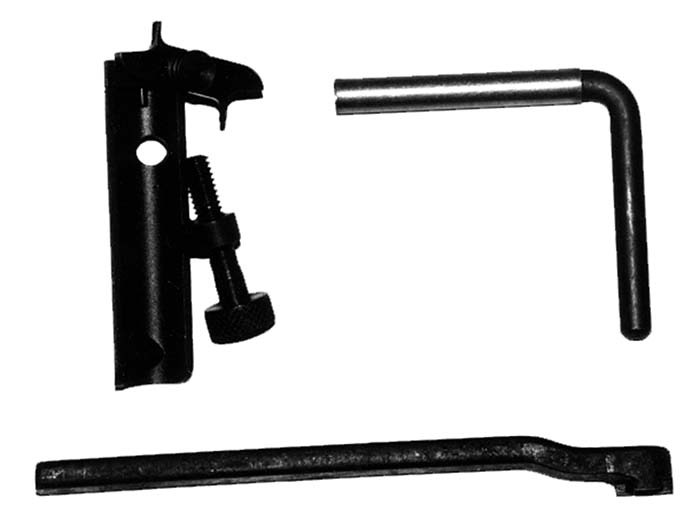
when the Research & Design request?for?Proposal was let to all the Prime Contractors in May 1944. It is a disputed historical conjecture that the Winchester conversion offered some theoretical mechanical advantages over the Inland submission, chief among them that the Winchester Number 3 Mechanism combined into the normal safety lever the additional aspect of a fire control selector, while the Inland design required a separate selector lever. Both the Inland and Winchester conversion used a remarkably similar lay?out and concept, deriving their selectable fire feature from a simple release lever operated by the operating slide during its return stroke, and acting on a simple hammer catch to time the release of the hammer to occur after final bolt lock?up. The Number 3 Mechanism also involved 3 fewer new or modified parts than did the Inland design, a fact that Winchester was unsuccessful in convincing the Board would be a major benefit to production considerations. All the while Winchester was being forced to change over their production set?up to the Inland designed M2 they continued without success to persuade the Army to reconsider their submission based on its obvious merits. Finally they conceded that their delay in introducing their submission had prevented it from being considered side?by?side with the Inland entry and on March 6, 1945, demonstrated one last time their conversion officially to the Ordnance Board who, predictably, stated that no matter the design merits it was a moot point as the M2 had already been in production as a standard design. Winchester knew they had lost and commenced full scale production of the M2 Carbine in early May, 1945. Despite losing out on their proprietary conversion Winchester was designated as the only other Prime Contractor, along with Inland, to be allowed to produce complete M2 Carbines under the auspices of the original Carbine Contracts.
It had come down to a function of opportune timing that the Inland design was chosen for standardization from their “Carbine, Caliber .30, T4”, their submission for testing. The T4 then, was standardized as the “Carbine, Caliber .30, M2” on October 26, 1944. The Hamisch?Sampson conversion was known by two different designations in official Military nomenclature: as a complete from?the?factory gun it was the “Carbine, M2”, as a conversion set of parts, designed to be field installed in existing M1 Carbines, it was known as the “Conversion kit, T17”. T17 kits were produced sparingly toward the end of the War alongside complete guns, to augment the demand from the Pacific Theater, but it was not until the Carbine rebuild programs came into full swing post?war that the T17 kit found its true destiny.
United States Patent #2,465,487
Engineers Paul H. Hamisch and Frederick W. Sampson were granted a US patent protection, United States patent number 2,465,487 on March 29, 1949 for their wartime work on the M1 Carbine conversion program at Inland. Their conversion kit was a basic redesign of the original operating mechanism utilizing as many of the original parts as possible, simply modified where feasible, combined with the addition of a few new parts, resulting in a mechanically simple and totally reliable new mechanism that retained all the Carbines’ desirable features while adding the added protection of full?automatic fire capability.
The actual conversion can be broken down into two distinct elements: original M1 mechanism parts that were suitably modified to accommodate the selective fire feature, and totally new parts added to the mechanism, required for the additional phase of the operating cycle when operating fully automatically.
Using the operating mechanics of the M1 carbine as a basis, it was found possible to slightly alter 4 elements as follows:
1. TRIGGER HOUSING? the standard M1 trigger housing was adapted by milling 2 additional features into the housing, a vertical clearance cut in the right hand side of the rear magazine support guide, and a small double half? circular cut in the left side of this same support face to form a retaining and dismounting surface for the selector lever spring. ( figure 2)
2. OPERATING SLIDE? by milling a semi?circular cut on the right side of the slide box at the juncture of the slide arm to provide an actuating surface for the added disconnector lever to run against and force the disconnector lever downward, necessary to actuate the disconnector block for tripping the hammer in full?automatic firing mode. (figure 3)
3. HAMMER ? by milling a clearance cut in the right hand side to accommodate the added disconnector block assembly; the hammer pivot pin now also serves to hold the disconnector block assembly in alignment against the (modified) sear. (figure 3)
4. STOCK? the stock is modified by milling two shallow surface cuts, one on the right hand side to allow the added disconnector lever to swing freely, the other on the left hand side to allow free movement of the added selector lever.
An additional two parts common to the standard M1 were required to be design altered and cannot be modified or remanufactured from base M1 parts:
1. SEAR? the M2 sear is design modified by adding a vertical ledge surface forward of the pivot pin hole to the top side to act as a contact surface for the added disconnector block to act on and allow hammer disengagement when in the full?automatic fire mode. (figure 3)

2. MAGAZINE CATCH? concurrent with the M2 carbine development request came the request to design a higher cartridge capacity magazine to take advantage of the M2’s increased firepower potential which culminated in the adoption of the familiar curved, 30?round capacity, M2 magazine. Due to the increased hanging weight of the 30?round magazine it was found necessary to augment the two lateral projections of the M1 mag catch by adding a third, finger shaped, projection to the left side of the catch arm to engage with an added third nib on the side of the new design magazine. Employed without this modified mag catch the 30?round magazine will consistently disengage from the M1 catch and drop from the gun when loaded full. Most M1’s were Arsenal updated to incorporate the M2 mag catch Post?War to allow interchangeable use of the original 15?round, or now standardized 30?round, mags. (figure 3)
The preceding six named parts may be interchangeably used in the M1 or M2 carbine as desired (although use of an M2 type hammer in an M1 will require a spacer between the right side of the trigger frame and hammer); they will give no functional change to the semi?auto only operation of an M1 carbine, and were routinely added to M1/M1A1 carbines that were Arsenal reconditioned in Post?War programs. By 1946 all of these parts were only being manufactured (or re?manufactured from wartime manufacture spare parts stocks) in the now standardized M2 configuration as only the M2 carbine was the standard version of the gun officially, with M1/M1A1 now listed as Limited Standard. Originally manufactured M1 parts may be found with any of the original Prime contractors, or their sub?contractors, markings existing in the M2 configuration, and were mixed indiscriminately with Springfield Arsenal new manufactured M2 parts in the rebuilt guns.
The second major division in the M2 conversion set was the addition of seven, actually issued as six, totally brand new parts (see figure 4) that were required to be added to the operating mechanism to allow selective fire as follows:
1. DISCONNECTOR BLOCK, SPRING AND PLUNGER? when operating in the full?automatic mode the trigger is lowered out of engagement, and only the sear is holding the hammer cocked. When actuated by the disconnector lever from the final dwell of the operating slide the disconnector block is pivoted upward from the front on its axis on the hammer pin and presses downward on the top surface of the M2 sear releasing the hammer to fire the cartridge primer. The top of the disconnector block contains a drilled hole for the placement of the disconnector spring and plunger, which act against the bottom surface of the receiver to apply a constant downward pressure to force the front of the disconnector block down in contact with the rear projection of the disconnector lever for reliability of operation. It also raises the rear finger off of the top sear contact surface to improve trigger pull characteristics.
2. DISCONNECTOR LEVER AND PIVOT PIN? as the connecting lever to convert mechanical movement of the operating slide to the vertical movement required of the disconnector block, the disconnector lever rides in the vertical camming surface of the modified operating slide undisturbed until the final dwell of the slide following bolt locking and then the front nose projection of the lever is forced downward by the milled camming cut of the slide causing the lever to pivot on it’s pivot pin raising the disconnector block to trip the hammer. The disconnector pivot pin is riveted (in all but the earliest parts) to the lever, and in the M2 carbine the disconnector pivot pin replaces the front trigger housing attachment pin. The pivot pin is attached to the lever at an eccentric and rotates under influence of the selector lever to either raise or lower the lever into or out of contact with the disconnector block, thereby achieving a selection of operating modes of fire.
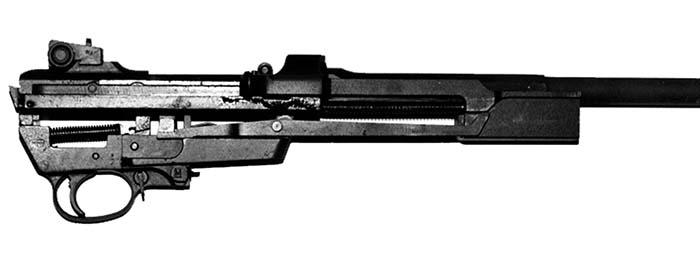
3. SELECTOR LEVER AND SPRING? a selector lever is added to the left side of the receiver area and in the front is connected to the disconnector pivot pin by a notched cutout in the selector mating with a notched cut on the pin. The selector lever rotates about this front mating notch on the pivot pin and is held in either of the two selectable positions by the tension of the selector lever spring, which is a half?moon shaped piece of spring steel pointed at the selector lever end and engaging in a hole in the rear of the selector and held in place on the trigger housing by the spring retaining hole described above. The spring is mounted or dismounted by sliding up or down through the dismounting notch cut in the trigger housing above the retaining notch. The selector lever is held only to the pivot pin and does not (SHOULD NOT!) contact either the trigger housing, receiver, or stock for reliable functioning.
The above salient features are the same for either original USGI carbines or after?market commercial clones. MOST mechanical operating parts will interchange between military and commercial production M2’s, although as discussed later, certain commercial carbines did depart from utilizing some of the traditional military parts as a manufacturing necessity as the surplus military parts scene changed.
A note of Caution: from a purely historical standpoint, the “second type” or “round bolt”, which has commonly, but erroneously, been come to be known as the “M2 bolt” was in fact NOT a result of the development of the M2 carbine, at all. It was, in fact, a result of studies by Inland designed to increase the reliability of the M1 carbine by providing an increased surface bearing area between the bolt and the receiver, thereby improving bolt ride during the operating movement of the bolt; it also had the secondary benefit to reduce manufacturing time of the M1 bolt by leaving off the final milling cut to the top surface of the bolt, and was an accepted production modification by the time the M2 came about. Notwithstanding historical errors, UNDER NO CIRCUMSTANCES should an M2 be operated WITHOUT a round bolt in place; it was quickly discovered by Inland that the flat bolt was subject to catastrophic failure under cyclic fire conditions due to harmonic torsional flexing and it is EXTREMELY RISKY to use this bolt in a machinegun version of the Carbine!! All original experimental Inland T4’s came with round bolts, as did all wartime production contract M2 guns, and the round bolt was replaced as needed in Arsenal rebuilt or converted M1’s.
Early factory produced M2’s and Arsenal Modified M1 guns often utilized a modification of the M1 stock, although it was found that in doing so, the milling cuts weakened the side rails of the stock and cracks and fractures were common. To alleviate this, the well known “Pot?Belly” style M2 stock was developed and issued. The Pot?Belly stock was identical to the M1 except that it contained more wood in the areas of the side rails to strengthen them against cracking. After WWII ended, all GI stock production was changed over to the Pot?Belly configuration, and as stocks needed replacing these were issued in the rebuilding programs as needed. There were numerous investigations into stocks made of alternate materials and manufacturing methods as fractured stocks were all too common place with the carbine during its’ issue lifetime; stocks made from laminated wood, plastic and even aluminum were all tested, but in the end they remained issued from but two selections of wood, standard Walnut and later Birch as the walnut shortages of Post?War times caused the search for an effective replacement for the normal walnut stock material. Both were used interchangeably and were listed as substituted standard issue. Most “new surplus” M2 stocks available today are of Birch wood and carry a lighter coloration than walnut. Both seem to give acceptable service although the Birch stocks seem to be more variable in their fit and finish.
So you want an M2 Carbine.Okay, which Flavor ??
So what IS an “M2 Carbine”? Well for the modern collector/shooter of NFA Title II weapons the “M2 Carbine” represents a bewildering array of choices and definitions. Defined PRECISELY, it means an original WWII production carbine, produced under the Hamisch?Sampson/Inland conversion design, by either Inland or Winchester, and factory marked M2. Keep in mind that many of the truly original Winchester WWII production M2 carbines were NOT marked “M2”, they were over stamped 2?over?1, only very late production guns were truly fully stamped “M2”; contrast that to the fact that almost ALL true original Inland Div. production M2’s WERE stamped “M2”!! There were no other military contracted M2 Carbines ever produced for the US Government, as from the factory guns. If you will allow a somewhat broader definition of “M2 Carbine”, to include any M1carbine that has been converted to fire in the selective fire mode, or Post?War clone production, the selections grow immensely.
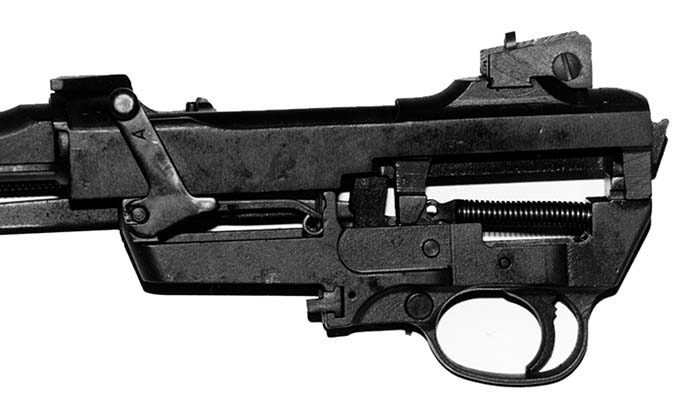
One must start with then, the original conversions that inspired the standardized M2, the Inland T4, which was produced to the extent of approximately 600 guns marked “T4”, which for all intents and purposes ARE M2’s. These guns would command a major premium in the collector markets as such. (There are many known private holdings of T4’s, they are rare and expensive, but out there. Most came from Inland directly after the War. ) Additionally, from the early part of the M2 saga, there are the One?off conversions done by Winchester and Springfield Armory during the initial conversion projects; several Winchester variations are held in the Cody Museum Collection. Springfield Armory examples/prototypes are held by the Smithsonian. There were also several post?war attempts by various people at bettering the Inland design. Granted, these all represent a rare line?up of M1 conversions, but they do exist, and from time to time some have come to the collectors market, although they are not M2’s they do occupy a significant place in the M2 Carbine story and may have interest to some collectors.
The next most obvious example is the MASSIVE number of M1 Carbines which were run through the various rebuilding programs that the Military held between the end of WWII and the Korean Conflict, and after the Korean Conflict ended, up to the Vietnam era. Not all M1’s were rebuilt as M2 configuration, but a LARGE number were. It is then, entirely possible to have a genuine USGI M2 carbine with a receiver marked as having come from ANY of the original Prime Contractors employed for WWII production. This is important knowledge when grading/pricing a gun you are looking at buying. It gets confusing!
When you stray from original Military production guns you arrive at the myriad number of post?war clones , production by such familiar makers as Iver Johnsons, Universal, and Plainfield Machine Co., all of whom made and marketed “M2” versions in several unique variations, such as the Enforcer Pistol, or Chrome plated M2’s, to the Civilian and Law Enforcement markets.
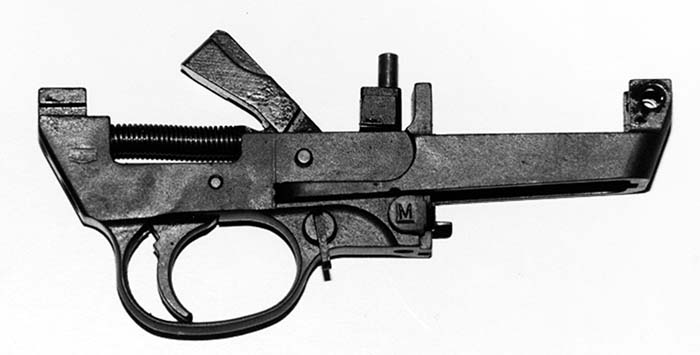
Finally, in terms of complete guns, there were the Presentation and Commemorative guns that came from both the original WWII production programs and later post?war civilian offerings. Some of the absolute most valuable M2’s are those few guns that Winchester Repeating Arms Co. presented to certain special members of management and to a few Military Liason Officers following their completion of the War Contracts; these guns, or certain numbers of them, are known to be M2’s and were registered to the presentee under the NFA ‘34.
The last source of NFA Title II guns are those multitude of “T17” kits that were registered as true conversion kits, in and of themselves, over the years until 1986, and were sold as an inexpensive way to convert an already held M1 to an M2. The vast majority of these kits were simply assembled from commonly available M2 spare parts, marked as required by Law, and then sold as a kit. There ARE however a select small number of Military Issue, and so Marked and Packaged, “Conversion Kit, T17”, which were acquired by various channels and then marked and registered too (It would be interesting if someone who owned one these original marked and packaged Military issue, but NFA registered, kits could persuade ATF Technology Branch to have them declared to be Curios & Relics eligible, in and of themselves.). The generic conversion kits are perhaps the most in need of a careful understanding when you go to purchase a gun that has been converted using a kit, or a bare kit itself. They were not always manufactured with the most complete understanding of the gun’s operating principal and as such, some bear watching out for!
| This article first appeared in Small Arms Review V1N2 (November 1997) |











